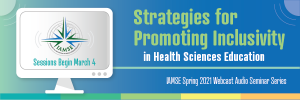
[The following notes were generated by Michele Haight, PhD.]
Amy Caruso Brown MD, MSc, MSCS, HEC-C , Associate Professor of Bioethics and Humanities and Associate Professor of Pediatrics, SUNY Upstate Medical University, Syracuse, New York, USA brownamy@upstate.edu
Creating Diverse, Equitable and Inclusive Content in Medical Education
Diversity, equity, inclusion and bias in health sciences education is a compendium of many different perspectives.
Addressing issues related to bias requires a shared definition for commonly used terms. These terms can be positive, negative or both.
- Prejudice: Preconceived opinion that is not based on reason or experience.
- Stereotype: Association of a member of a group with a consistent set of traits.
- Bias: Inclination or prejudice for or against something
- Implicit or Unconscious Bias: Relatively unconscious and relatively automatic features of prejudiced judgment and social behavior; contrasted with explicitly endorsed beliefs. Implicit to Explicit represents a spectrum, not a dichotomy.
Bias in health sciences education can be placed into four categories:
- Who? Who is admitted to medical school? Who is hired to teach?
- What? What content is presented to learners?
- How #1? How are learners taught, mentored and evaluated?
- How #2? How do learners see health professionals treat patients and families?
There are four categories of bias within the area of content:
- Scientifically inaccurate information.
- Promotion of race as a biological as opposed to a social construct, racial essentialism.
- Overemphasis of certain topics; Neglect of other topics
- Unequal distribution of time in pharmacology dedicated to men’s and women’s reproductive issues.
- Disproportionate representation of white skin and white able-bodied images.
- Promotion of bias, shame and stigma towards people belonging to certain groups or with certain medical conditions.
- E.g., fat-shaming, poverty=laziness, all patients who speak Spanish are undocumented workers.
- Irrelevant to medicine and promotes bias and discrimination
- Humor and microaggressions
What doe bias look like on multiple-choice exams?
- Diseases associated with specific races
- Male and female stereotypes
- Instantaneous judgments of patients with certain characteristics
- Epidemiology without context
- Use of race as a proxy for genetics
- Absence of white privilege
- Race as meaningful for only non-white identities
- Race is represented negatively and associated with disparities without mention of community strengths
Bias in content and the learning environment is costly:
- Lowers faculty productivity and student/faculty retention
- Reduces quality of care
Our biases are mitigated by our:
- Positionality
- Discomfort with discussing racial issues
- Lack of real-world data
- Lack of time and effort for closer examination
Current curricular and assessment paradigms in health sciences education make it difficult to identify biases.
Dr. Caruso Brown has developed a checklist instrument for identifying content biases; this tool is publicly available at https://tinyurl.com/UpstateBiasCheklist
Guiding Questions for examining content include the following:
- Why is the content at risk for bias?
- How might it impact learners?
- What is the goal/learning objective for this part of the content? Why is the content there in the first place?
- Should it be changed?
- How should it be changed?
There are four recommended methods for changing content:
- Remove content
- Replace content with images that challenge stereotypes
- Add content
- Apologize (last resort)
Mapping the attributes of hypothetical patients used in the curriculum via the spreadsheet provided in the checklist tool provides an opportunity for a systematic review of potential biases across the curriculum. This type of review also helps to identify the pervasiveness of biases across the curriculum and provides the opportunity to enhance equity within the curriculum.
Addressing Bias in Content Development
- Offer faculty and students a session unpacking race as a social construct before they start learning from case studies or real patients.
- Use tables to track representation over entire courses and curricula. Regularly reassess for over or under representation. (Equity mapping)
- Practice counter-stereotypic imaging.
- Incorporate discussion of structural and social determinants of health into cases including a discussion of a patient’s relative vulnerability or privilege based on the patient’s racial classification.
- When race and stereotype may align within the case, faculty should talk explicitly about that and promote stereotype replacement, individuating and perspective-taking.
- Consider introducing the patient’s race in a paragraph with additional information about the patient’s family and social and cultural background, rather than in the first sentence.
Pros and Cons for Including Race in Case Development:
Pros
- People notice race
- Racial and ethnic identities and experiences matter and can impact care
- Learners often make assumptions about race if it is not mentioned
Cons
- It is easy to fall back on race as proxy for genetics
- Faculty are not trained to view racism as a risk factor
- Faculty do not want to write about rare combinations